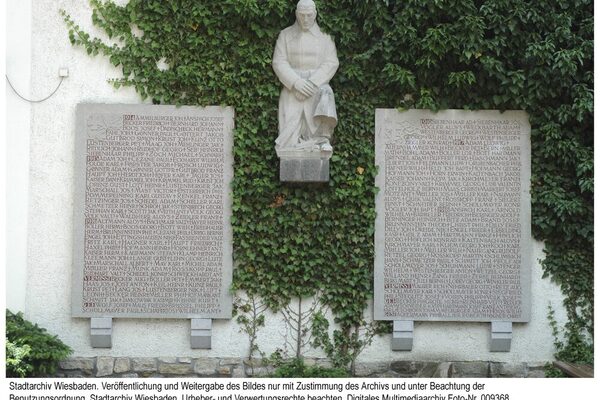The First World War in Wiesbaden
The outbreak of the First World War hit Wiesbaden particularly hard in terms of its economic support: because it was part of the Mainz fortress area, all foreigners had to leave the city, and many German spa guests also turned their backs on the city. To compensate for this, the magistrate tried to assign as many wounded soldiers and officers as possible. Numerous schools, hotels, the Paulinenschlösschen and Schloss Biebrich were converted into military hospitals, and the number of beds in the town's hospitals was increased.
As soon as the war broke out, the prices of certain foodstuffs such as potatoes doubled within a few days and there were hoarding purchases of all kinds. Food had been rationed since 1916 and was only distributed in exchange for ration cards. Again and again, there were spontaneous riots of hungry people. The lack of fuel was also a major problem. In order to keep the spa guests in the town despite the difficult food situation, the residents' meat rations were reduced in the spring of 1916 in favor of those of the spa guests. The anger of the population was then directed against the "spa foreigners", and there were occasional riots against foreigners and anti-Semitic remarks. Four public and one middle-class kitchen were set up. From 1915, vegetables were grown in tree nurseries and in the municipal nursery for the hospitals and the Red Cross, allotment gardening by private individuals was promoted through the distribution of seeds, and the city provided land for the cultivation of vegetables and potatoes on its own initiative.
In order to keep the population happy despite the food crisis and the grueling duration of the war, they were deliberately disinformed, for example about the alleged successes of the advancing German army or with reports about alleged atrocities committed by the enemy. The churches placed themselves at the service of the army command with war prayer days and war sermons. In order to strengthen the will to persevere, model trenches were erected in July 1915 on the grounds opposite the main railway station to depict the supposedly safe situation of the soldiers at the front. The installation of captured guns on Kaiser-Friedrich-Platz in October 1915 also served propaganda purposes.
The spa administration tried to maintain normality: concerts by the spa orchestra continued to be held regularly, interrupted only in winter due to a lack of coal. Operas and musical evenings were performed in the Royal Theatre and the Residenztheater. Three cinemas provided entertainment.
"I gave gold for iron" - this slogan engraved on watch chains and rings is emblematic of the excessive collections carried out among the civilian population from the beginning of 1915 due to the supply shortages caused by the war. The appeals to contribute to the war bonds, which were carried out with great propaganda effort, also appealed to the population's willingness to make sacrifices. Women's associations and the Red Cross played a leading role in this. In 1915, the Red Cross also commissioned the "Iron Siegfried", an almost 4-metre-high nail sculpture by Wiesbaden sculptor Carl Wilhelm Bierbrauer. The money raised from the sale of the nails was used to support the survivors of the war and the wounded.
After unemployment had prevailed at the beginning of the war, a serious shortage of labor became apparent as the war progressed; as a result, more and more women were employed as conductors in armaments factories, in the munitions industry or on streetcars.
On October 23, 1918, the city was the target of an air raid. There were several detonations and a total of seven bombs were dropped. 13 people, including several children, lost their lives. Despite the defeat, the returning soldiers were celebrated like victors. However, the idea of the beginning of a better time, which many people associated with the end of the war, was dashed: unemployment, hyperinflation and the French occupation with all its restrictions on the economy and daily life very quickly dashed these hopes.
Literature
Fink, Otto: Wiesbaden as it was, Düsseldorf 1976 [pp. 58-69].
Müller-Werth, Herbert: Geschichte und Kommunalpolitik der Stadt Wiesbaden unter besonderer Berücksichtigung der letzten 150 Jahre, Wiesbaden 1963 [pp. 131-145].
Schmehl, Hendrik: The outbreak of war in Wiesbaden in 1914. Unpublished master's thesis, Mainz 2011.
Streich, Brigitte: The spa town of Wiesbaden during the First World War. In: Engels/Streich/Teske, First World War [pp. 58-79].
